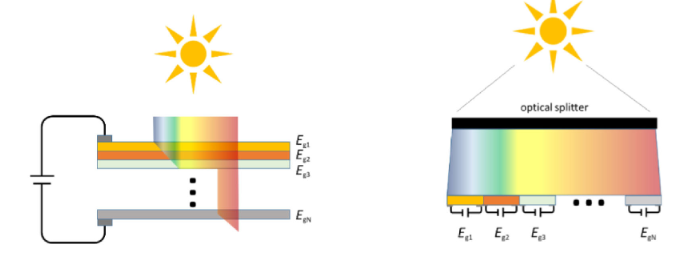Solar energy stands as one of the most promising solutions to address the world’s growing energy needs while reducing our carbon footprint. A pivotal aspect of harnessing solar power efficiently lies in the development of solar cells, and among them, multijunction solar cells have emerged as a beacon of hope, offering theoretical conversion efficiencies exceeding 60%.
Three distinguished FAU Solar Members, Marius Peters, Larry Lüer and Christoph Brabec, have undertaken a comprehensive study to explore the intricacies surrounding multijunction solar cells. The findings shed light on the technical and economic factors governing their performance.
Multijunction solar cells exhibit increased efficiency as the number of junctions within them rises. However, the research unveils the presence of limitations that become more pronounced with the increasing number of junctions. Spectral variations, for instance, induce current losses in series-connected tandem solar cells, which are especially pertinent when considering locations such as Denver. Under non-concentrated light conditions, these losses diminish achievable harvesting efficiencies to 51% and impose restrictions on the ideal number of junctions, which should be less than nine for optimal performance.
Furthermore, the study reveals that independently operated solar cells suffer from optical losses, even when optical efficiencies reach an impressive 99%. These losses constrain the ideal number of junctions to fewer than 10 and reduce overall efficiencies by over 10%. The research emphasizes that architectures with sequential cell illumination display greater resilience against these losses.
From an economic perspective, the study underscores that, for most practical applications, it is economically prudent to employ five junctions or fewer.
This research contributes significantly to our understanding of the complex dynamics governing solar cell efficiency. It underscores the importance of considering both technical and economic factors in the quest to optimize solar energy solutions. Marius Peters and Christoph Brabec’s dedication to advancing renewable energy technologies at FAU exemplifies the university’s commitment to pioneering research that addresses critical global challenges.
Link to article in Progress in Photovoltaics (open access)

Solar energy stands as one of the most promising solutions to address the world’s growing energy needs while reducing our carbon footprint. A pivotal aspect of harnessing solar power efficiently lies in the development of solar cells, and among them, multijunction solar cells have emerged as a beacon of hope, offering theoretical conversion efficiencies exceeding 60%.
Three distinguished FAU Solar Members, Marius Peters, Larry Lüer and Christoph Brabec, have undertaken a comprehensive study to explore the intricacies surrounding multijunction solar cells. The findings shed light on the technical and economic factors governing their performance.
Multijunction solar cells exhibit increased efficiency as the number of junctions within them rises. However, the research unveils the presence of limitations that become more pronounced with the increasing number of junctions. Spectral variations, for instance, induce current losses in series-connected tandem solar cells, which are especially pertinent when considering locations such as Denver. Under non-concentrated light conditions, these losses diminish achievable harvesting efficiencies to 51% and impose restrictions on the ideal number of junctions, which should be less than nine for optimal performance.
Furthermore, the study reveals that independently operated solar cells suffer from optical losses, even when optical efficiencies reach an impressive 99%. These losses constrain the ideal number of junctions to fewer than 10 and reduce overall efficiencies by over 10%. The research emphasizes that architectures with sequential cell illumination display greater resilience against these losses.
From an economic perspective, the study underscores that, for most practical applications, it is economically prudent to employ five junctions or fewer.
This research contributes significantly to our understanding of the complex dynamics governing solar cell efficiency. It underscores the importance of considering both technical and economic factors in the quest to optimize solar energy solutions. Marius Peters and Christoph Brabec’s dedication to advancing renewable energy technologies at FAU exemplifies the university’s commitment to pioneering research that addresses critical global challenges.
Link to article in Progress in Photovoltaics (open access)